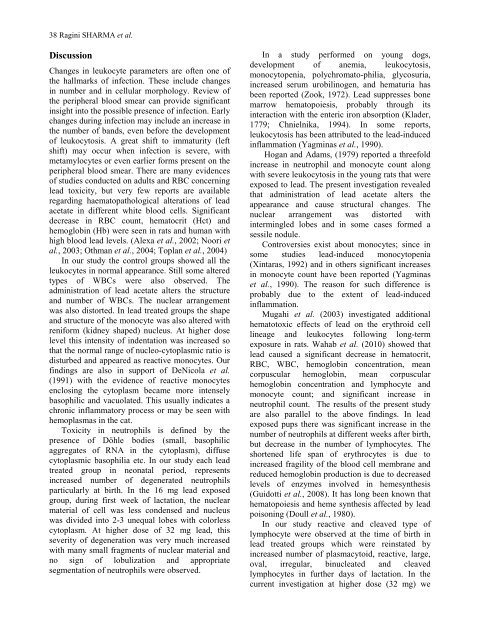10 1 Full Volume (PDF)(jcmb.halic.edu.tr) - Journal of Cell and ...
10 1 Full Volume (PDF)(jcmb.halic.edu.tr) - Journal of Cell and ...
10 1 Full Volume (PDF)(jcmb.halic.edu.tr) - Journal of Cell and ...
Create successful ePaper yourself
Turn your PDF publications into a flip-book with our unique Google optimized e-Paper software.
38Ragini SHARMA et al.<br />
Discussion<br />
Changes in leukocyte parameters are <strong>of</strong>ten one <strong>of</strong><br />
the hallmarks <strong>of</strong> infection. These include changes<br />
in number <strong>and</strong> in cellular morphology. Review <strong>of</strong><br />
the peripheral blood smear can provide significant<br />
insight into the possible presence <strong>of</strong> infection. Early<br />
changes during infection may include an increase in<br />
the number <strong>of</strong> b<strong>and</strong>s, even before the development<br />
<strong>of</strong> leukocytosis. A great shift to immaturity (left<br />
shift) may occur when infection is severe, with<br />
metamylocytes or even earlier forms present on the<br />
peripheral blood smear. There are many evidences<br />
<strong>of</strong> studies conducted on adults <strong>and</strong> RBC concerning<br />
lead toxicity, but very few reports are available<br />
regarding haematopathological alterations <strong>of</strong> lead<br />
acetate in different white blood cells. Significant<br />
decrease in RBC count, hematocrit (Hct) <strong>and</strong><br />
hemoglobin (Hb) were seen in rats <strong>and</strong> human with<br />
high blood lead levels. (Alexa et al., 2002; Noori et<br />
al., 2003; Othman et al., 2004; Toplan et al., 2004)<br />
In our study the con<strong>tr</strong>ol groups showed all the<br />
leukocytes in normal appearance. Still some altered<br />
types <strong>of</strong> WBCs were also observed. The<br />
adminis<strong>tr</strong>ation <strong>of</strong> lead acetate alters the s<strong>tr</strong>ucture<br />
<strong>and</strong> number <strong>of</strong> WBCs. The nuclear arrangement<br />
was also distorted. In lead <strong>tr</strong>eated groups the shape<br />
<strong>and</strong> s<strong>tr</strong>ucture <strong>of</strong> the monocyte was also altered with<br />
reniform (kidney shaped) nucleus. At higher dose<br />
level this intensity <strong>of</strong> indentation was increased so<br />
that the normal range <strong>of</strong> nucleo-cytoplasmic ratio is<br />
disturbed <strong>and</strong> appeared as reactive monocytes. Our<br />
findings are also in support <strong>of</strong> DeNicola et al.<br />
(1991) with the evidence <strong>of</strong> reactive monocytes<br />
enclosing the cytoplasm became more intensely<br />
basophilic <strong>and</strong> vacuolated. This usually indicates a<br />
chronic inflammatory process or may be seen with<br />
hemoplasmas in the cat.<br />
Toxicity in neu<strong>tr</strong>ophils is defined by the<br />
presence <strong>of</strong> Döhle bodies (small, basophilic<br />
aggregates <strong>of</strong> RNA in the cytoplasm), diffuse<br />
cytoplasmic basophilia etc. In our study each lead<br />
<strong>tr</strong>eated group in neonatal period, represents<br />
increased number <strong>of</strong> degenerated neu<strong>tr</strong>ophils<br />
particularly at birth. In the 16 mg lead exposed<br />
group, during first week <strong>of</strong> lactation, the nuclear<br />
material <strong>of</strong> cell was less condensed <strong>and</strong> nucleus<br />
was divided into 2-3 unequal lobes with colorless<br />
cytoplasm. At higher dose <strong>of</strong> 32 mg lead, this<br />
severity <strong>of</strong> degeneration was very much increased<br />
with many small fragments <strong>of</strong> nuclear material <strong>and</strong><br />
no sign <strong>of</strong> lobulization <strong>and</strong> appropriate<br />
segmentation <strong>of</strong> neu<strong>tr</strong>ophils were observed.<br />
In a study performed on young dogs,<br />
development <strong>of</strong> anemia, leukocytosis,<br />
monocytopenia, polychromato-philia, glycosuria,<br />
increased serum urobilinogen, <strong>and</strong> hematuria has<br />
been reported (Zook, 1972). Lead suppresses bone<br />
marrow hematopoiesis, probably through its<br />
interaction with the enteric iron absorption (Klader,<br />
1779; Chnielnika, 1994). In some reports,<br />
leukocytosis has been at<strong>tr</strong>ibuted to the lead-induced<br />
inflammation (Yagminas et al., 1990).<br />
Hogan <strong>and</strong> Adams, (1979) reported a threefold<br />
increase in neu<strong>tr</strong>ophil <strong>and</strong> monocyte count along<br />
with severe leukocytosis in the young rats that were<br />
exposed to lead. The present investigation revealed<br />
that adminis<strong>tr</strong>ation <strong>of</strong> lead acetate alters the<br />
appearance <strong>and</strong> cause s<strong>tr</strong>uctural changes. The<br />
nuclear arrangement was distorted with<br />
intermingled lobes <strong>and</strong> in some cases formed a<br />
sessile nodule.<br />
Con<strong>tr</strong>oversies exist about monocytes; since in<br />
some studies lead-induced monocytopenia<br />
(Xintaras, 1992) <strong>and</strong> in others significant increases<br />
in monocyte count have been reported (Yagminas<br />
et al., 1990). The reason for such difference is<br />
probably due to the extent <strong>of</strong> lead-induced<br />
inflammation.<br />
Mugahi et al. (2003) investigated additional<br />
hematotoxic effects <strong>of</strong> lead on the erythroid cell<br />
lineage <strong>and</strong> leukocytes following long-term<br />
exposure in rats. Wahab et al. (20<s<strong>tr</strong>ong>10</s<strong>tr</strong>ong>) showed that<br />
lead caused a significant decrease in hematocrit,<br />
RBC, WBC, hemoglobin concen<strong>tr</strong>ation, mean<br />
corpuscular hemoglobin, mean corpuscular<br />
hemoglobin concen<strong>tr</strong>ation <strong>and</strong> lymphocyte <strong>and</strong><br />
monocyte count; <strong>and</strong> significant increase in<br />
neu<strong>tr</strong>ophil count. The results <strong>of</strong> the present study<br />
are also parallel to the above findings. In lead<br />
exposed pups there was significant increase in the<br />
number <strong>of</strong> neu<strong>tr</strong>ophils at different weeks after birth,<br />
but decrease in the number <strong>of</strong> lymphocytes. The<br />
shortened life span <strong>of</strong> erythrocytes is due to<br />
increased fragility <strong>of</strong> the blood cell membrane <strong>and</strong><br />
r<s<strong>tr</strong>ong>edu</s<strong>tr</strong>ong>ced hemoglobin production is due to decreased<br />
levels <strong>of</strong> enzymes involved in hemesynthesis<br />
(Guidotti et al., 2008). It has long been known that<br />
hematopoiesis <strong>and</strong> heme synthesis affected by lead<br />
poisoning (Doull et al., 1980).<br />
In our study reactive <strong>and</strong> cleaved type <strong>of</strong><br />
lymphocyte were observed at the time <strong>of</strong> birth in<br />
lead <strong>tr</strong>eated groups which were reinstated by<br />
increased number <strong>of</strong> plasmacytoid, reactive, large,<br />
oval, irregular, binucleated <strong>and</strong> cleaved<br />
lymphocytes in further days <strong>of</strong> lactation. In the<br />
current investigation at higher dose (32 mg) we
















